Philip Craig Russell has been working steadily in the comic book field for close to 40 years now. Though his first full comic job was an Ant-man book, it was his extended run of Killraven/War of the Worlds in Amazing Adventures for Marvel that brought him into the spotlight. His eye for design and lyrical beauty have made him an artist’s artist, while his ability to move between the mainstream and the more personal projects gave him a freedom that few of his contemporaries share. His work has remained at a consistently high level of quality throughout his career, with no real artistic missteps along the way. Russell knows himself and knows what he wants to do with his work. It’s our good fortune that we get to see him pursue his muse. I conducted this interview live through the Facebook chat window.
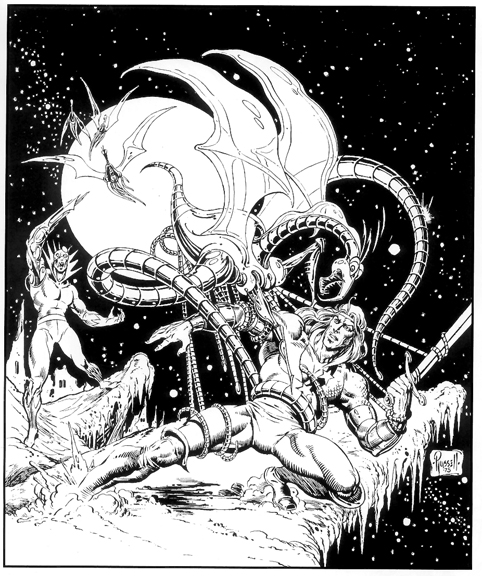 Before I get started, I have a confession to make. I am a total geeked out fanboy when it comes to Craig Russell. His Killraven work figured mightily in my early development (meaning, I swiped a lot of his work in my futile quest to become a comic artist of his caliber and skill). As I looked again at his work in the past including Dr. Strange, Elric, and his many adaptations, I came to realize that I could think of no one who shows the beauty of this world (and others) like P. Craig Russell. We see the beauty of the natural world in his Jungle Book adaptations. We see the architectural beauty of the Mideast in his adaptation of The Thief of Bagdad. And we see the beauty of the human body in…well, everything. I cannot think of anyone who has elevated the human figure to such a state of lyrical and visual rapture as Russell.
Before I get started, I have a confession to make. I am a total geeked out fanboy when it comes to Craig Russell. His Killraven work figured mightily in my early development (meaning, I swiped a lot of his work in my futile quest to become a comic artist of his caliber and skill). As I looked again at his work in the past including Dr. Strange, Elric, and his many adaptations, I came to realize that I could think of no one who shows the beauty of this world (and others) like P. Craig Russell. We see the beauty of the natural world in his Jungle Book adaptations. We see the architectural beauty of the Mideast in his adaptation of The Thief of Bagdad. And we see the beauty of the human body in…well, everything. I cannot think of anyone who has elevated the human figure to such a state of lyrical and visual rapture as Russell.
ComicAttack: What actually made you start drawing in the first place? Did you start tracing from comics as I did?
P. Craig Russell: We always had some time to draw in grade school and kindergarten. I seemed to enjoy it more than most others.
CA: I actually have a picture from a newspaper my grandmother cut out, where I was sitting at a painting easel at about 6…and was told I would never be an artist because I did not draw feet on my people. Did you get a lot of encouragement from teachers and your parents?
PCR: Yes, though not in any overbearing way. It was never considered as important as academic subjects. My teachers found uses for my talent in class. I could contribute that way. And I loved the attention.
CA: Did you ever get into any trouble doing it? I actually got thrown out of an art class in high school because I did an unflattering caricature of my art teacher.
PCR: I did the caricatures but never got caught. I did get caught drawing ‘cigarette girls’ in 7th grade and got a very strange look from my Ohio History teacher and a warning to cut it out.
CA: Maybe you should tell the audience what a cigarette girl is…
PCR: You see them in old movies, usually a night club. They go table to table with a little box hanging in front of them, selling cigarettes. They’re dressed very provocatively. Mine always had fishnet stockings.
CA: When you got into comics early on, did you have buddies you would hang around with reading and drawing? Was there much of a community there for you?
PCR: Not at all. Early on, before I was a teenager and before the ‘Marvel age’ kids in the neighborhood traded comics, I had only one friend for a year or so who’d borrow my comics but no sort of community.
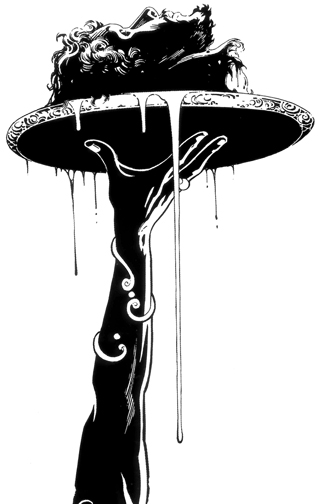 I also liked classical music at an early age. I had all sorts of interests that no one else seemed to share.
I also liked classical music at an early age. I had all sorts of interests that no one else seemed to share.
CA: Right…I was going to ask when the opera interest started, but I guess it started a very early age. It’s obviously very different from your average teenage marvel zombie…listening to Jethro Tull and BTO.
PCR: It was more a part of the culture at large then. Opera singers popped up on the Ed Sullivan Show and on Carson. I just had an ear for it from age 5 on. It was so beautiful to me I just assumed everyone else would feel the same. Boy, I found that to be untrue.
CA: Yeah, I bet…most kids are just listening to the radio, rock and roll and watching The Munsters or something. I think an interest like that comes so much later in life for most people
PCR: The Munsters had great theme music. Likewise, The Addams Family.
CA: True. The opposite was true with me. It was only in college with a constant exposure to other forms of music that I started liking different forms of rock and folk. It took me that long to get into progressive rock and until only 15 years ago to start listening to jazz fusion…Miles Davis, etc. Opera seems like a whole other world, especially for someone at that age…
I wonder if it stems from the film scores of the day, which were much more operatic and less cut and paste than today’s soundtracks.
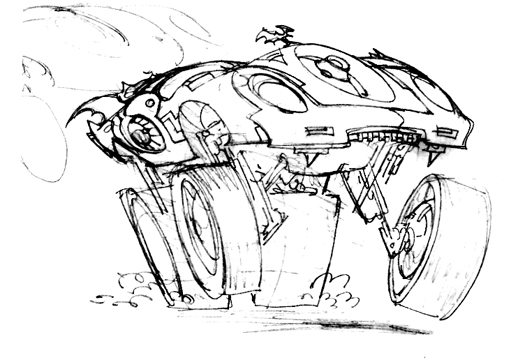 PCR: The first record I had was a yellow 78 that had 2 kid’s songs to a side. They were set to classical tunes though I didn’t know it at the time. The film scores were all classically influenced and Disney’s Sleeping Beauty was all Tchaikovsky. I do love a lot of contemporary film scores.
PCR: The first record I had was a yellow 78 that had 2 kid’s songs to a side. They were set to classical tunes though I didn’t know it at the time. The film scores were all classically influenced and Disney’s Sleeping Beauty was all Tchaikovsky. I do love a lot of contemporary film scores.
CA: I have always had a hazy memory of some film with a magical score that I had dreams about forever, but never seemed to get a good enough grip to really identify it. But, getting back to comics, was there a pivotal comic or more importantly, a pivotal artist who drove you to start thinking about doing comic work?
PCR: Before there were credits I knew who the good duck artist was, who drew the best Casper and who the best Betty and Veronica artist was (Dan De Carlo). Around the age of 11 or 12 when Marvel started crediting artists I really started studying styles. Wood, Kirby, Ditko, etc. They all made me want to draw. Al Williamson inspired me the most, I think. The first comic page I ever drew was pure imitation Williamson.
CA: I have a very hazy memory of your Ant-man and Dr. Strange work… but an almost photographic memory of many panels from Killraven. I was so taken with the lyric beauty of that artwork. I seem to remember noticing a familiarity between that and the work of the mature Barry Smith…is that the right timeline and did he influence you at all back then?
but an almost photographic memory of many panels from Killraven. I was so taken with the lyric beauty of that artwork. I seem to remember noticing a familiarity between that and the work of the mature Barry Smith…is that the right timeline and did he influence you at all back then?
PCR: Yes, Smith was a big influence just at the time I was beginning, Steranko as well, two very dissimilar artists. I also was studying many of the artists that Smith was studying so a lot of what I drew that was attributed to a Smith influence was actually the Pre-Raphaelite artists.
CA: It was Smith that led me to the Pre-Raphaelites in the first place and now that you mention it, I can see Steranko as well. I think I actually saw Smith more in the inks than anything else.
PCR: That’s true, it was in the inks. A lot of us picked up certain inking mannerisms. I also tremendously admired Smith’s storytelling and layout abilities, something that I think is sometimes overlooked in appreciations of his work. I think he’s one of the best storytellers ever in this field.
CA: Very true…I saw the pencils for that Hulk story that never saw print…and that Avengers 100 was just tremendous for me. I think the similarity I see in both Smith and Steranko is that their figures were tall and lithe and seemed to float just barely above the ground…something I just thought of as we were talking.
PCR: I still had some reservations about his drawing up until Hawks from the Sea and then I was totally enamored. Hawks was his return to Conan after a 2 or 3 issue leave. Dan Adkins inked. That run culminated with The Song of Red Sonja, his swan song on the monthly book.
CA: Smith’s Red Sonja…boy oh boy. I used to have all those issues of Conan and Savage Tales…until my mom burned ’em all.
PCR: Yikes.
CA: I would like to seque into fanzines for a bit, since that is the subject of Ink Stains.
PCR: OK
 CA: I do recall seeing your work in fanzines, but I think it was actually only after you were a pro, is this right?
CA: I do recall seeing your work in fanzines, but I think it was actually only after you were a pro, is this right?
PCR: Yes.
CA: Darn! I was hoping I was wrong and would unearth some great fanzine I could search for!
PCR: I did some things for Bob Layton’s CPL. Also a couple Buyers Guide covers.
CA: Yes, I have those CPL issues! Or at least a few…in fact, I already did a column on the one with the Gulacy cover.
PCR: Not too much else. I was never connected to fandom as a kid, unfortunately.
CA: How did you get involved with CPL?
PCR: Duffy Vohland was a friend of Bob’s. Duffy moved to East Liverpool when I was working with Dan Adkins. Later when Duffy moved to NYC, I stayed at his place when I made my move. Through him I met Bob, Roger Slifer and some others. I think they were all from Indiana.
CA: Yeah, they even called themselves the Indiana Mafia or something like that.
PCR: Right. Duffy moved to be near Dan, though Dan kept telling people (about me) “he’s not my assistant.”
CA: You have been doing comics for over 30 years now and keeping an incredible level of quality while you were doing it. What drives you to keep creating and more to the point, creating comics?
PCR: Its 37 years and I just seem to like the competition with myself. In a sense, my lack of formal training in things like anatomy and perspective has kept me on my toes, I always have to solve problems. In other words, hacking is not the option or temptation it is to someone who can phone it in.
CA: Well, you could have fooled me. Your  work is so smooth, it appears effortless, though I know it isn’t.
work is so smooth, it appears effortless, though I know it isn’t.
PCR: The eraser is my friend. We’re on a first name basis.
CA: When you were starting out, or a least a bit into your career, did you have any long term goals you have realized or yet to realize? Your numbering of the strips (Opus, 1, 2, etc) would lead someone to believe you had a master plan.
PCR: By the end of my first year I knew one day I’d adapt The Ring of the Nibelung and that it would be one very big project. Once I started The Fairy Tales of Oscar Wilde I knew I wanted to do all 9 and that it would be spread over many years. Likewise, the opera projects. I knew I wanted to do 12 and I’ve completed 11. The opus numbers were simply to let readers know what might be missing if they were following my work. I once had a plan to do 100 or 101 opus numbers but now, with the development of the graphic novel, projects seem to be longer and require much more time to complete so I might not get there.
CA: The scope of most of those projects just boggles my mind. Anything that you are working on now that we can expect to see anytime in the near future?
PCR: There’s the cycle of projects I’m doing with Neil Gaiman. They tend to be longer also. I’d like to do 12. Working on 7, 8 and 9 right now. Guess I like that number. I’m doing an 8 page Spirit story that Will Pfeiffer wrote for me for DC comics. And there’s going to be a volume of Gaiman adaptations for Dark Horse.
CA: I was so glad when Joe (Pruett) 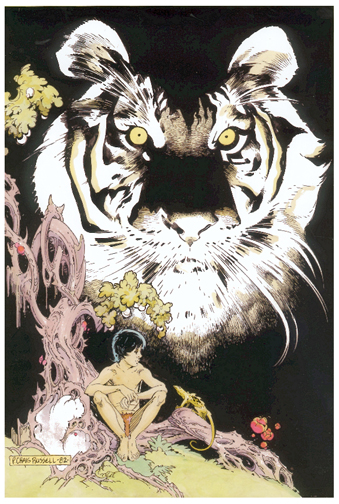 told me he was doing a book on/with you…the retrospective is such an incredibly beautiful book. And the behind the scenes stuff was great, too.
told me he was doing a book on/with you…the retrospective is such an incredibly beautiful book. And the behind the scenes stuff was great, too.
PCR: Thanks. I loved working on it. Just doing pure design was a thrill. It also inspired me to do a number of new pieces for the book.
CA: You ought to come down here to SCAD sometime to do a lecture. You would be so appreciated, and there are some great instructors here.
PCR: I’d love to come down to SCAD sometime. I visited there some years ago. Still carry the SCAD keychain with me everyday.
CA: Well, my hour of glory is up. Craig, as someone who has just plain idolized your work for many, many years, I appreciate you taking the time to talk to me.
PCR: Hey, it’s been fun; my first chat interview.
I would like to thank Joe Pruett and Malcolm Bourne for assistance, and of course, P. Craig Russell.
Ken Meyer Jr.
kenmeyerjr@yahoo.com



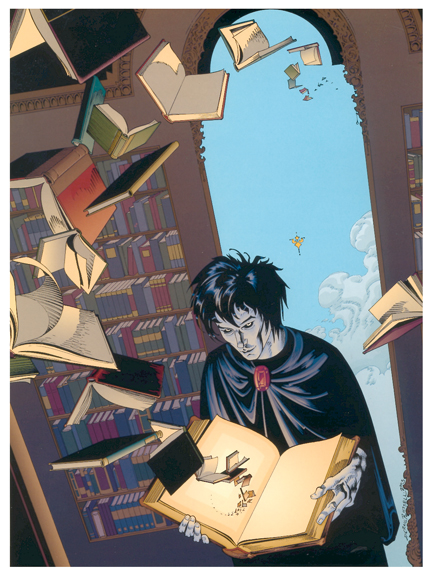



Very cool KM. You are one lucky guy getting to talk to a legend like that! Those price guide covers are way cool. As is the Doc Strange pic.
I know, Billy, I know! He has been an idol of mine for going on 30 years!